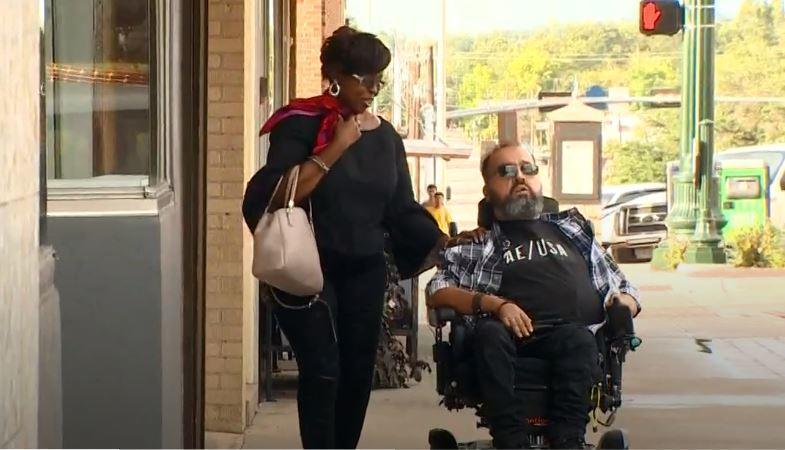Muscular Dystrophy Patient's Sweet Proposal to Girlfriend of Two Years
This muscular dystrophy patient made sure to give his girlfriend a proposal that she would never forget.

Photo source: WFMY News 2
Michelle Henderson received a marriage proposal in an exceptional way and to a unique man. She dated Val Vera for two years and things were going great, and when they moved toward the Courthouse in the Square on a date, she had no idea that something special was about to happen.
Val’s friend turned on a portable speaker and turned on Bruno Mars’ Marry You. A group of six dancers from Texas Woman’s University ran into the square and turned into a flash mob. A flash mob is a group of “strangers” who gather together in a public place and dance or act in a predetermined manner for a set amount of time and then quickly disappear.
A dancer, Melissa Gonzales, pulled Michelle away from Val and talked her into dancing with the group. Dancing with the group was fun, and Michelle was game. However, when Martha Hernandez, the lead dancer, called Michelle by name, this was somewhat startling. What came next was so sweet and surprising. Hernandez handed an engagement right to Val Vera, and Michelle suddenly knew what was happening.
Michelle Henderson was amazed and excited simultaneously. Val explained, “Because of my limited dexterity, I’ve had the wedding ring in my backpack for like two months, so I asked Martha, ‘Can you please take the ring, [and] keep it?’”
About six weeks before the proposal, Vera contacted the dancers at TWU, and they gave him an answer to his plan one week later. Hernandez agreed to do the choreography and pull together a group of dancers to help Vera’s marriage proposal come together. Hernandez and Vera had never met before; it didn’t matter, the dancers were excited to be a part of the ceremony.
Vera gave the ring for safekeeping to Hernandez and two other dancers when he met with them,and the dancers all teared up when Vera showed them the ring. They were excited to be a part of Val Vera’s proposal to Michelle Henderson.
The dancers volunteered their time to dance and meet as a group at least four times over the next three weeks to rehearse. They balanced their time between their schoolwork and their jobs.
“Everyone has worked really hard with the time crunch that we have had,” Hernandez said. “We got the whole dance done in two rehearsals and just practiced as much as we could the other rehearsals.”
Michelle Henderson and Val Vera: Their History
Michelle, 51, and Vera, 50, connected through a dating and support website specifically for people with disabilities. Henderson’s vocal cords are partly paralyzed after treatment for esophageal cancer. She speaks in a soft and low whisper. Vera is in a wheelchair and suffers from muscular dystrophy.
Vera had been married and wasn’t looking for someone to date. However, he felt an immediate connection with Henderson when they met on an online dating site for people with disabilities. The two are originally from Chicago, but Vera has since moved to Texas. The two lovebirds traveled from Chicago to Texas to see each other before they moved to Denton, Texas to learn more about each other.
Vera loves Denton and feels welcomed by the community. In Denton, he is involved with a local disability chapter and has plans to keep volunteering.
Michelle Henderson shares Vera’s interest in volunteering. She is planning on pursuing a degree from TWU.
The Challenge of Muscular Dystrophy
Val Vera was born with muscular dystrophy, and he spends his days in a wheelchair. The muscular dystrophy that affects Val Vera is congenital muscular dystrophy, which is apparent at birth or before age 2.
Some forms of congenital muscular dystrophy progress slowly and cause only mild disability, but other forms development quickly and cause severe impairment. Vera has learned over the years to live with his progressing disability, and he is a strong advocate in finding help and cures for muscular dystrophy.
Muscular dystrophy is caused by abnormal genes or mutations interfering with the production of proteins that form healthy muscle. There are different muscular dystrophy types, and most of the most common types begin in childhood, and generally affect boys. There is no cure for muscular dystrophy, but medication and therapy helps manage and slow the course of the disease.
Complications of muscular dystrophy include:
- Trouble walking. Those with difficulty walking often need to use a wheelchair.
- Shortening of muscles or tendons around joints or contractures. Contractures further limit mobility in all the limbs.
- Breathing problems. The muscles associated with breathing are often affected by progressive weakness. Those with muscular dystrophy may eventually need to use a ventilator.
- Scoliosis or a curved spine. Scoliosis is often part of muscular scoliosis. Weakened muscles cannot hold the pine straight.
- Heart problems. The heart is one big muscle. Muscular dystrophy can reduce the efficiency of the heart muscle.
- Swallowing problems. The muscles used to swallow may be affected by muscular dystrophy. If this happens, aspiration pneumonia may develop, and nutritional problems became an issue. Feeding tubes may become an option.
There is no cure for any form of muscular dystrophy. Treatment may help prevent and reduce problems and help those with the disease live more active lives. Treatments contain medications, physical and occupation therapy, and surgical procedures are an option.
Medications include Eteplirsen, which is the first medication approved by the FDA specifically to treat Duchenne muscular dystrophy. Eteplirsen will not cure DMD, but it may help increase muscle strength. Eteplirsen works on some gene variants that affect about one in seven people with DMD.
Corticosteroids like prednisone can help with muscle strength and delay the progress of some forms of muscular dystrophy. However, using corticosteroids for long periods of time will cause weight gain and weakened bones.
Heart medications like ACE inhibitors (angiotensin-converting enzyme) or beta blockers can be used if muscular dystrophy is damaging the heart muscle.
Therapy is used on those with muscular dystrophy to improve the quality of life in patients. Some therapies include:
- Range of motion and stretching exercises. Muscular dystrophy restricts the flexibility and mobility of joins. Limbs draw inward and become fixed in one position. Range of motion exercises helps keep joints flexible.
- Exercise. Low impact aerobic exercises like walking and swimming help maintain strength and mobility. Some strengthening exercises are also helpful.
- Braces. Braces keep muscles and tendons flexible. Braces help slow the progression of contractures.
- Mobility Aids. Walkers, wheelchairs, and canes are often used to maintain mobility and balance in those with muscular dystrophy.
- Breathing assistance. When respiratory muscles weaken, the patient may need to use a sleep apnea machine to help improve oxygen levels during the night. Those with severe muscular dystrophy may also need to use a ventilator.
Surgery is often used to correct spinal curvatures that might make breathing difficult.
It is essential to take care of the health of someone suffering from muscular dystrophy. A good diet is necessary to keep up with the nutritional needs of someone in a wheelchair and swimming may take care of exercise needs.
Respiratory infections may become a severe problem for those with muscular dystrophy. Be vaccinated for pneumonia and the flu. It’s also important to avoid contact with other who have apparent respiratory infections.















